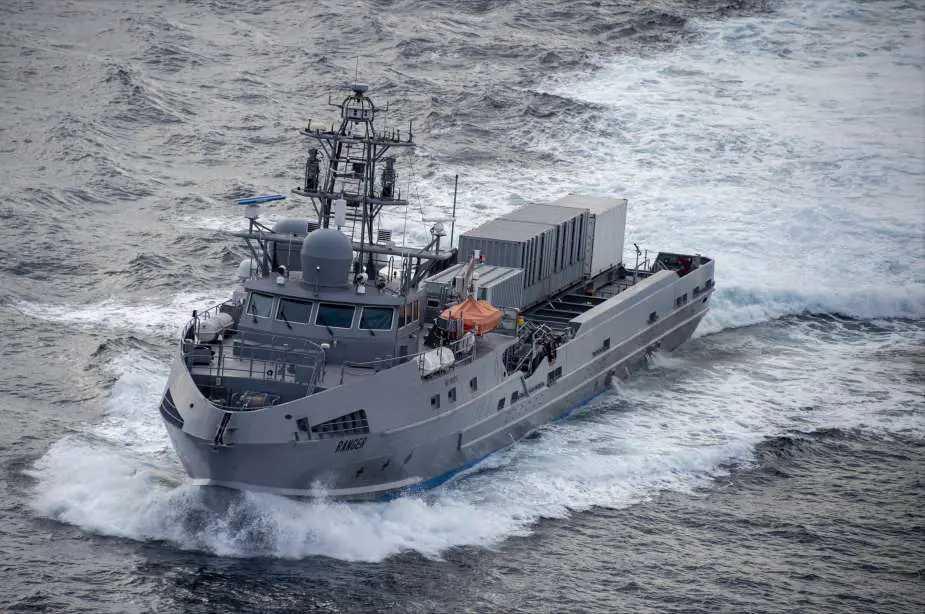US Navy deploys Ranger and Mariner unmanned vessels for naval exercises in Japan.
According to the South China Morning Post on October 22, 2023, the United States recently deployed two multi-role unmanned surface vessels (USVs), the Mariner and Ranger, to its naval bases in Japan. The USVs, belonging to the US Navy Third Fleet, traveled from California to Yokosuka, Japan, last month to participate in the US Navy's Integrated Battle Problem 23.2 exercise (IBP23.2).
Follow Navy Recognition on Google News at this link
 The USV Ranger is part of the US Department of Defense's initiative to integrate autonomous navigation technology into existing seagoing vessels. (Picture source: US Navy)
The USV Ranger is part of the US Department of Defense's initiative to integrate autonomous navigation technology into existing seagoing vessels. (Picture source: US Navy)
This deployment marked a significant milestone for the US Navy, as it marked the first long-distance journey of unmanned ships. The USVs were accompanied by the Arleigh Burke-class destroyer USS Shoup during their Pacific crossing.
Lu Li-shih, a former instructor at the Taiwanese Naval Academy, observed that employing unmanned vessels alongside warships represents a new approach in naval combat, similar to the modern air combat tactic of pairing unmanned aerial vehicles (UAVs) with fighter jets during aerial battles. The use of drone boats and UAVs is part of an offset strategy aimed at reducing the number of combatants in modern warfare, thus potentially reducing casualties.
Lu also noted that the Ranger seemed to have made stops in Guam and Okinawa, as indicated by satellite imagery and maritime traffic identification systems. These USVs are equipped with combinable weapons modules, including the US Navy's Standard Missile-6, which can perform air defense, terminal ballistic missile defense, and anti-ship strike functions.
Despite having the world's most extensive navy in terms of total tonnage, the United States maintains around 280 warships compared to China's 425 active warships as of August 2023, a number projected to increase to 440 by 2030. The US Navy's Chief of Naval Operations (CNO) Navigation Plan 2022 envisions the American naval fleet expanding to approximately 523 ships by 2045, comprising 373 manned ships and 150 unmanned ships.
Scott Savitz, a military expert at the Rand Corporation, suggested that Taiwan should cooperate with the US to deploy explosive USVs as a deterrent against potential Chinese aggression. The recent conflict in Ukraine demonstrated the effectiveness of explosive USV, such as the Magura V5, and Savitz believes Taiwan could address communication challenges to ensure the efficient operation of these unmanned ships.
China, meanwhile, has made substantial progress in USV technology. State-owned China State Shipbuilding Corporation unveiled a 340-tonne multipurpose unmanned combat surface vessel (UCSV) with advanced radar systems, making it challenging to detect and capable of precise targeting. However, the US Navy's extensive combat experience may provide an advantage in developing USV technology.
The Ranger, and its sistership Mariner, introduced in 2022, belong to an US unmanned surface vehicles (USVs) class and are part of the Department of Defense's initiative to integrate autonomous navigation technology into existing seagoing vessels. Developed through a partnership between defense technology company Leidos and Gulf Craft, the Ranger is a medium unmanned surface vehicle (MUSV) measuring 193 feet in length and 32 feet in width. Initially designed for fast crew transfer and supply missions in the offshore oil and gas industry, it has undergone significant modifications for military use.
The Ranger is equipped with satellite communications, three radars of different bands, electro-optical and infrared sensors, radios, and an operator override function. It retains cargo transport capabilities, with fore and aft decks able to carry two 20-foot and four 40-foot containers, often housing additional systems and sensors crucial for its operations. The vessel is powered by five 2,000-horsepower (1,491 kW)diesel engines connected to waterjets, with redundancy provided by multiple oil filters for each engine. The vessel operates autonomously but can be overridden by a small crew in emergencies. Further testing and modifications are planned, with the goal of enabling refueling without a crew on board by 2023.






















